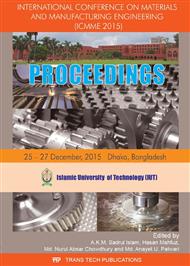p.105
p.111
p.117
p.123
p.129
p.134
p.140
p.146
p.152
Effect of Sintering Time on Dielectric Properties of Barium Titanate and Nb Doped Barium Titanate
Abstract:
Barium titanate (BaTiO3) with its perovskite structure is a promising dielectric material for many applications such as transducers, actuators, high-k dielectrics and multilayer ceramic capacitors (MLCC). In this study, we have investigated the effect of sintering time on dielectric properties of BaTiO3 and Nb-doped BaTiO3. BaTiO3 was doped with 0.3 mol % niobium oxide (Nb2O5). At first, nanosized pure BaTiO3 and Nb2O5 doped BaTiO3 were milled, dried and pressed into pellets to prepare green samples. Then, the samples were sintered at 1275°C for different time periods ranging from 2 to 5 hrs. Single stage sintering was adopted for the densification of prepared samples. Microstructure of the sintered samples was investigated employing Field-emission scanning electron microscope (FESEM). Dielectric properties of the samples were measured using an impedance analyzer. Finally, a correlation was established between the dielectric properties of the sintered samples and their microstructure. Nb has shown to provide strong inhibiting effect after sintering the samples in the range of 2 to 5 hours at 1275°C thereby, resulted in higher dielectric properties of doped BaTiO3 ceramics compared to that of pure BaTiO3. The best room temperature dielectric constant of 7200 was obtained for Nb doped BaTiO3 sintered at 1275°C for five hours. Such improved dielectric constant is attributed to the optimum grain size of about 1 micron at this sintering temperature.
Info:
Periodical:
Pages:
129-133
Citation:
Online since:
December 2016
Authors:
Keywords:
Price:
Сopyright:
© 2017 Trans Tech Publications Ltd. All Rights Reserved
Share:
Citation:


